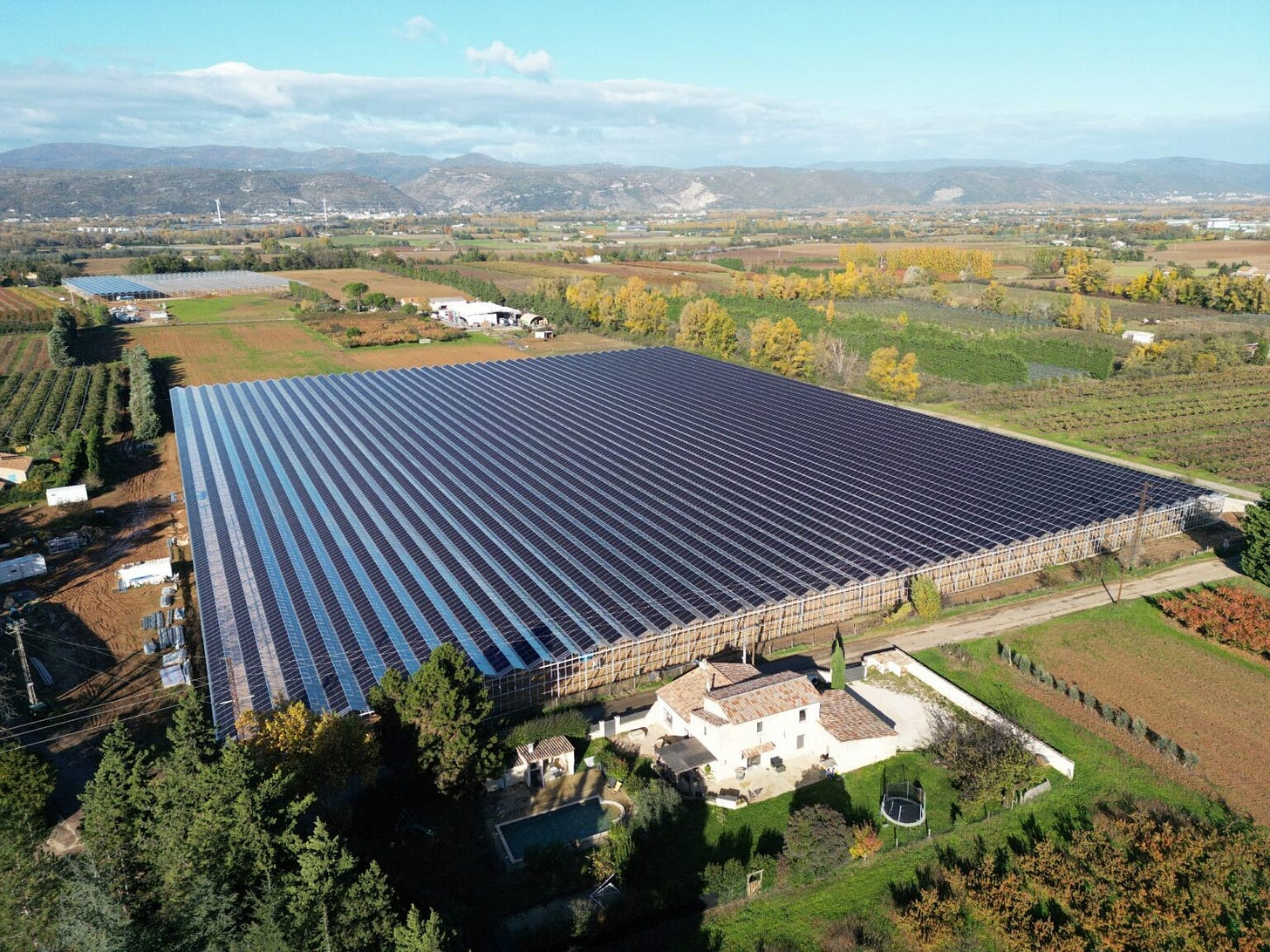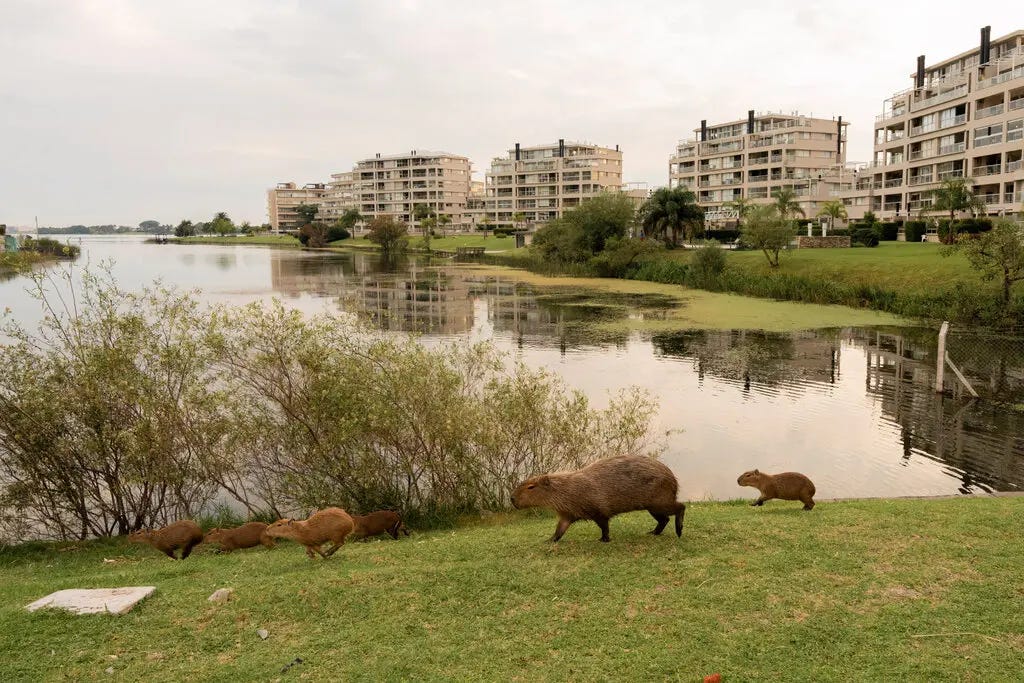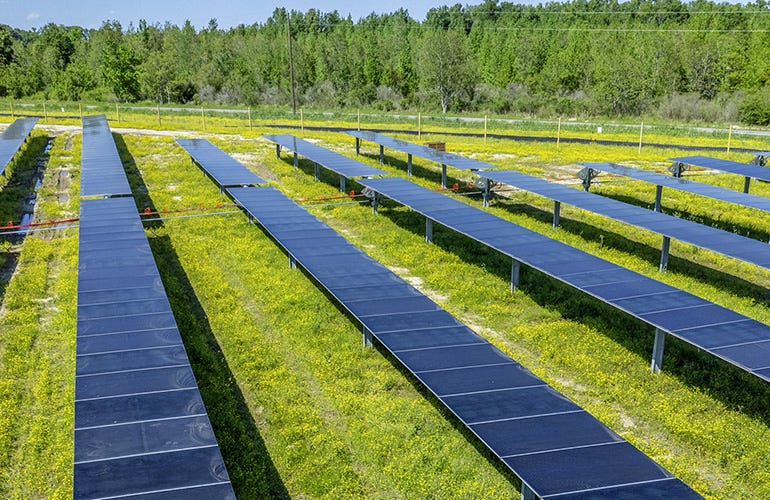The Weekly Anthropocene, April 30 2025
Agrivoltaics, Captain Canada, China's cleantech, Project CETI, penguins and capybaras in Argentina, solar in the USA, amazing alligators, the world's largest wildlife crossing, and more!
The Big Picture: Agrivoltaics

A landmark new study has calculated that agrivoltaics, the growing of crops under solar panels, is suitable for a very large chunk of all existing farmland across Earth’s surface. Their headline result is that about 22% to 35% of rain-fed harvested area globally would likely continue their current crop yields if solar panels were added, with the agrivoltaic setup helping to reduce water stress by protecting the crops from heat. Now let’s supercharge this perfect synergy for Anthropocene Earth!
“Agrivoltaics cannot be applied everywhere, but according to our results, it would be possible to combine cultivation and energy production in many areas of the world without significant reductions in yield.”
— Nikolas Gallo, coauthor of the new study
Canada
Canada held its 2025 federal election on April 28, 2025, and it has been won by the incumbent Liberal Party. The Canadian Prime Minister for the foreseeable future will be the excellent Mark “Captain Canada” Carney, a former central bank head and longtime leader on climate action who has lately become a global symbol of resistance to MAGA stupidity and brutality. This is one of the greatest political comebacks in any democracy ever! As recently as early February 2025, leading election sites forecast >99% odds that the Conservative Party would win Canada’s 2025 election. Canada has chosen to make a statement for freedom, democracy, and sanity — spectacular news!
“We will strengthen our relations with reliable partners in Europe, Asia and elsewhere. And if the United States no longer wants to be in the forefront of the global economy, Canada will.
We are masters in our own home. We will build millions of housing units. We will become an energy superpower…
…It’s time to build an industrial strategy that makes Canada more competitive while fighting climate change.”
—Prime Minister Carney’s victory speech
China
President Xi Jinping committed China to its strongest-ever emissions reduction targets at a recent virtual meeting of global leaders which the U.S. did not attend. Xi pledged to set new emissions-cutting goals for 2035 that would include all of the Chinese economy and all greenhouse gases, not just the “big beasts” of carbon dioxide and the power sector. For context, China already achieved its 2030 target of installing 1,200 GW (1,200,000 MW) of renewables capacity in mid-2024 — six years early.
As of the end of March 2025, China has installed 1,482 GW of renewables capacity - overtaking fossil fuels capacity for the first time, and still growing incredibly fast! Despite this, renewables provided just 22.5% of China’s electricity in Q1 2025, with much of the electricity from the new solar and wind capacity going to waste, but China’s giant under-construction high-voltage power lines should soon help with that.
Coal burning for electricity generation declined in China by 4.7% year-on-year from Q1 2024 to Q1 2025 even as total electricity demand rose by 1%. Cleantech: it works!
Dominica
For years (to the ongoing fascination of this newsletter!) the pioneering Project CETI international research effort has been using undersea audio analysis and AI to try to understand and translate the communication of sperm whales (Physeter macrocephalus) in the waters around the Caribbean island nation of Dominica1.
The project has already discovered a “sperm whale phonetic alphabet” of 156 distinct click sequences, and they now hope to build a “Google Translate for sperm whales,” potentially allowing true high-level interspecies communication. Fascinating work!
France
An agrivoltaic greenhouse project has been built to grow kiwi fruit in southeastern France. The greenhouses improve cultivation by protecting the kiwi from bacterial blight disease and extreme weather damage — and preventing exposure to the mistral winds means that less water is required for irrigation. Furthermore, the two greenhouses collectively host 5 MW of solar capacity, providing electricity to 3,000 people in the region. This is an excellent example of simultaneous climate action and climate resilience — and a great model to scale up around the world!
Laos
For the first time ever, the Southeast Asian nation of Laos has ordered the closure of one of the country’s infamously cruel bear bile farms, with three rescued Asiatic black bears (Ursus thibetanus, aka “moon bears”) now being cared for at the NGO-run Luang Prabang Wildlife Sanctuary. A step forward!
Argentina
In 2021, a local rancher perpetrated a cruel “backhoe massacre” at Punta Tombo, a major magellanic penguin (Spheniscus magellanicus) breeding colony in Argentina. Now, the backlash has resulted in an overall brighter future for the species: a court just found the rancher guilty (an important precedent!) and the Argentinian government is working to expand the Punta Tombo protected area, where about 180,000 breeding pairs of penguins nest each year, from about 500 acres to nearly 4,000 acres. A potential new conservation management plan and proposals to strengthen wildlife crime enforcement are also being discussed. Great news!
Elsewhere in Argentina, magellanic penguins have established a new breeding colony on a trash-covered beach — an unusual choice, but one that appears to be working out for them. From just 12 individual “founder” penguins in 2008, there are now over 8,000 penguins nesting there, and new community conservation efforts are underway.
In recent years, the population of wild capybaras (Hydrochoerus hydrochaeris) has increased dramatically in the suburbs of Buenos Aires. The local government is now attempting a contraceptive program — but many pro-capybara local residents are opposing it. Another interesting example of human coexistence with large wildlife!
Zambia
The central African nation of Zambia just enacted some truly excellent pro-clean energy permitting reform, with the Ministry of Energy mandating that all solar power projects must receive government approval (or disapproval, but that’s pretty unlikely right now) in less than 48 hours. This will likely further accelerate Zambia’s already-epic development-boosting solar boom! A superb model for the world.
United States
Though criminal wannabe-autocrats at the executive branch continue their horrific cruelty and idiotic deindustrialization, Americans continue to fight for a better future.
Solar and wind have contributed 97.6% of new electricity-generating capacity coming online in the U.S. in January and February 2025 (6,309 MW), with fossil “natural” gas providing just 2.3% (147 MW). Solar alone accounted for 73.3% of new U.S. capacity in those two months2! Solar power has now been the largest source of new power-generating capacity in America for 18 months in a row, since September 2023.
Relatedly, solar power generation numbers are achieving record highs across the U.S.!
A major planned LNG (liquified “natural” gas) project in Louisiana is reportedly undergoing serious difficulties due to the tariff omnishambles, as “around half of the equipment and materials needed to develop the project would need to be imported.”
U.S. solar developer Silicon Ranch just raised $500 million in 2025 as investors showed confidence in its “more or less tariff-proofed” domestic solar supply chain amid high demand for clean energy. Silicon Ranch gets its solar panels from leading U.S. manufacturer First Solar. Despite idiotic attacks, solar providing overwhelming majorities of new U.S. power-generating capacity is looking like a lasting trend!
A wave of new research has found that American alligators (Alligator mississippiensis) play an underappreciated role as valuable ecosystem engineers in the Florida Everglades and other U.S. wetlands. Alligators excavate burrows and nests which then fill with water, becoming new ponds that are havens for many plant and animal species during the dry season. They also circulate nutrients through the water with their feces and their stirring up of sediment. Researchers have also recently discovered that some individual alligators routinely venture out to sea and spend as much as 18 hours straight in the ocean, which may help bring marine nutrients into the wetlands. All this likely means that alligators are enabling much higher carbon storage in ecosystems where lots of them are present. Good thing we saved them from extinction thanks to conservation in the 20th century — the U.S. alligator population has risen from perhaps 100,000 in the 1950s to over 5 million today! Awesome.
Waymo is now delivering over 250,000 fully autonomous commercial robotaxi rides per week across the United States. Notably, Waymo has already launched a long-term partnership with Hyundai to build all-electric Ioniq robotaxis, and available data indicates that Waymo’s self-driving cars are substantially safer than human drivers.
New EV startup Slate Auto has gone public with their plans for a super-simple, ultra-cheap, and right to repair-enabled U.S.-made electric pickup truck! Great potential.
Power demand on the New England grid dropped to another record low of 5,318 MW on April 20, 2025. That’s 20% (over 1,200 MW) lower than one year ago in 2024. This is overwhelmingly due to the rise of “behind-the-meter” rooftop solar letting households power themselves — at its peak during the sunny afternoon, behind-the-meter solar provided about 6,600 MW to New England on April 20! Great news.
A new construction milestone has been achieved at the under-construction Wallis Annenberg Wildlife Crossing in Los Angeles, California. In April 2025, the first layers of soil began to be added to the nascent bridge, with the first complete soil-carrying girder placed on April 17. A total of 82 such girders are planned to span the ten-lane US-101 highway, with this wildlife crossing set to become the world’s largest when complete in 2026. By then, it should include about 6,000 cubic yards of soil and over 5,000 plants, providing key habitat connectivity to cougars and more. Great work!
Notably, Dominica is not the same place as the Dominican Republic, which shares the island of Hispaniola with Haiti elsewhere in the Caribbean.
The best I can tell, these statistics from FERC appear to not be counting grid-scale batteries as a source of dispatchable power in the same “bucket” as wind and solar, unlike what EIA statistics do and what some previous charts in this newsletter have been based on. Slightly confusing, but the upshot is clear: lots and lots of new solar, very little new fossil fuels!













1. I love to eat kiwi fruit, particularly the "gold kiwi" variety.
2. "Omnishambles" is a fabulous word.
3. Another fantastic newsletter!
I'm obsessed with that agrivoltaics stat, such good news! As much as 35% of crops suitable for pairing with solar?! Reminds me of Steve Hanley's piece this week on how much land is wasted growing ethanol corn. Solar sure seems like a great use of land... https://substack.com/home/post/p-162339942